How we transfer 36 million customers to a digital technical support service
At Rostelecom, we have long thought about translating voice client service into digital text-based communication channels. For small companies, the task looks easy, but when it comes to service from hundreds, and in the future even thousands of support operators, there is a lot to think about. In this post we will tell you what solution you have found for this, what it generally represents and allows you to do. Spoiler: a lot of things.

Now more and more people prefer social networks and messengers to regular telephone communication. Therefore, Rostelecom decided to transfer its support to popular digital channels. We needed not just an instant messenger, but a product capable of making support manageable and convenient for analysis, to answer important questions. Why is the load on operators growing? How many need them now? Where does the money go? And this is only the most basic.
For some time we studied the platforms for handling calls in digital channels and decided to try LiveTex. When we started integrating chat into a personal account in 2015, this was the most famous and probably the most functional solution. Perhaps the LiveTex solution would be suitable for several operators who are sitting at arm's length and can solve any customer disturbances without getting up from the chairs. But for the scale of "Rostelecom" service was not sufficiently transparent and manageable.
The list of alternatives turned out to be only solutions written on the knee, which could not meet all the requirements of a large contact center. With them, sooner or later, any big company would face the fact that its support in IM channels would plunge into total chaos.
The search for third-party options resulted in the decision to try the development of one of the Rostelecom competence centers - Rostelecom Contact Center. Thus began the piloting of the OmniChat system, designed for large contact centers.
Its solution gives scope for scheduling tasks. The goal of Rostelecom was to increase the availability of the service for users. It was necessary to increase the number of available channels of interaction, add instant messengers and social networks. The digital platform was supposed to automate typical maintenance tasks — at least answering frequently asked questions without operator intervention or minimal intervention. And do not calm down on any chat bot, but prepare the constructor and create as many chat bots as you like for all communication channels. OmniChat had to reduce the time costs of the support service specialists, have a convenient interface and connect the knowledge base.
Finally, a tool was needed for calculating financial indicators (for example, the cost of contact with the user) using the analytics of the data that we receive through numerous interaction channels - the time of receipt of an appeal, the waiting period, the response time, etc.
Chat rooms are chat rooms, and on the part of the screens there are still experts. And if we change the format of communication with customers, it is necessary that these specialists could easily integrate into it. At first it was not clear what to demand from future OmniChat operators how to evaluate them. They simply took the "best of the best", those who have proven themselves for a long time.

Over time, basic requirements began to form. It is important that a person knows how to type quickly and, very desirable, blindly. Writing should be competent and concise - the extra words result in extra human seconds and costs for the contact center.
But this is not the main thing. The most important skill turned out to be awareness of their responsibility for the work to the client and the company. When communicating via voice channels, everything is simpler - the client rarely sits with the voice recorder during a conversation, so minor reservations do not create problems. With chats, everything is not so - “what fell on the Internet remains there forever”. Any typo is a direct path to negativity in social networks, problems for the image. At best, everyone just laugh. It is important, for example, that “Julia” retains her beautiful name.
On the other hand, when working in chat rooms, speech defects and emphasis no longer matter. A person can burr, stutter, or “gokat”, but if he competently writes and clearly expounds his thoughts - you can take. True, only to work in text channels, but this is a nuance of internal organization.
In the regions, it was sometimes a problem to find people with computer literacy. But came across and prosharennye users who even helped to modify the interface "Omnichat", for example, to make more vivid switching between active channels.
At Rostelecom, we wanted to communicate with customers as positive and fun, with “emoticons and cats”, but without familiarity and rudeness. “Well said, comrade humanities, how will we automate this?”
Without a clear objective analysis of the dialogues, developing a system for communicating with customers will not work. At the time of the launch of "OmniChata" we, of course, had almost no text dialogues. But there was a mass of voice dialogues and a clear idea of their structure and logic.

It took time to create a ready base for this analysis and systematization. So, for a start, the standards of voice service were adopted as the basis for the assessment, where instructions were added on the use of emoticons, cute pictures and friendly Internet jargon.
For six months, Rostelecom, together with its partners, transferred its “voice legacy” to the base, ready for analysis. All dialogues were divided into 250 topics. In each topic, an assessment system was introduced for three components with a number of criteria included:
In addition, the assessment that the client gives to the operator is taken into account.
In the near future we will automate the quality control of the dialogs. So subjective factors will not affect the assessment - the reviewer will not know whose dialogue and from which region he is viewing. Yes, and quality control itself will accelerate.
The systematization of the dialogues has helped us very much to build optimal scripts and formulate pools of auto-answers - they are always in quick access with the operators. This, again, speeds up work and reduces the number of errors when printing messages. It’s not far from automatic replies and to creating chat bots that can automatically process messages and, at a minimum, choose the right templates for operators. You can integrate any external chat bot into OmniChat.
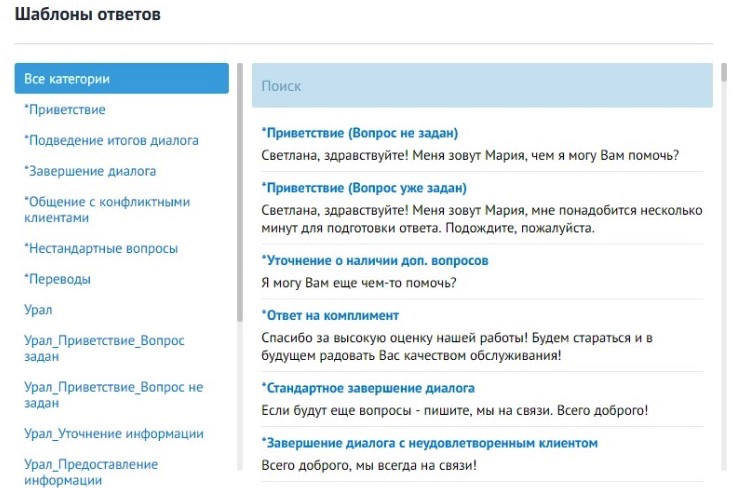
In general, in terms of integration, "OmniChat" turned out to be convenient. Clients have the opportunity to contact us both in Viber, and in the personal account, via chat on the site or in a mobile application. If necessary, you can integrate into the "OmniChat" VK and Facebook social networks.
During the project, the opportunity to regularly upload to Excel reports on 25 important parameters was implemented: call arrival time, response time, waiting period, processing time, service level (share of the total number of calls in relation to a specific processing time threshold), call subject, etc. In addition, OmniChat's statistics and reporting can be integrated into any BI system — it will provide a report on important metrics in real time.
For operational control, statistics on key indicators are sufficient - service level, AHT (average time of communication with the client), CSAT (user satisfaction). In a separate dashboard, you can track the load on the client service. There is a geography of calls, their channels and dynamics:


Statistics can be divided into skill groups and operators:
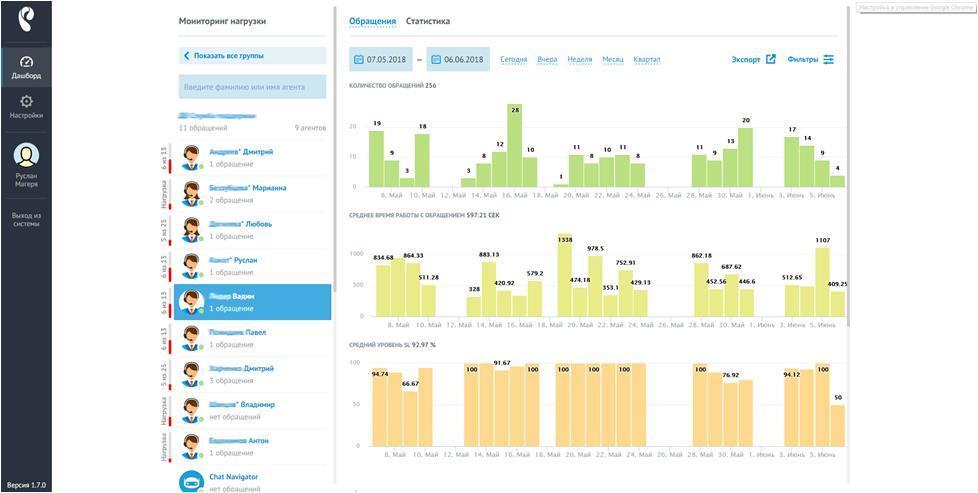
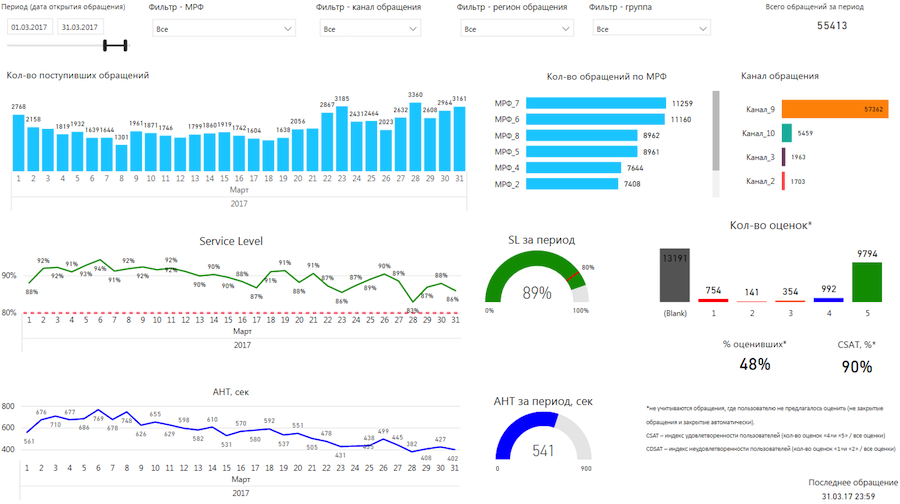
In order to plan resources using WFM-systems or Erlang calculator, there is a dashboard with hourly load profiles by skill-groups. OmniChat can quickly distribute the load on operators and groups, allocate a queue, output the required number of operators “in line”:

To monitor the work in the context of topics there is a three-level classifier synchronized with a voice channel (CRM). Here you can also estimate the duration of work with appeals on each topic:
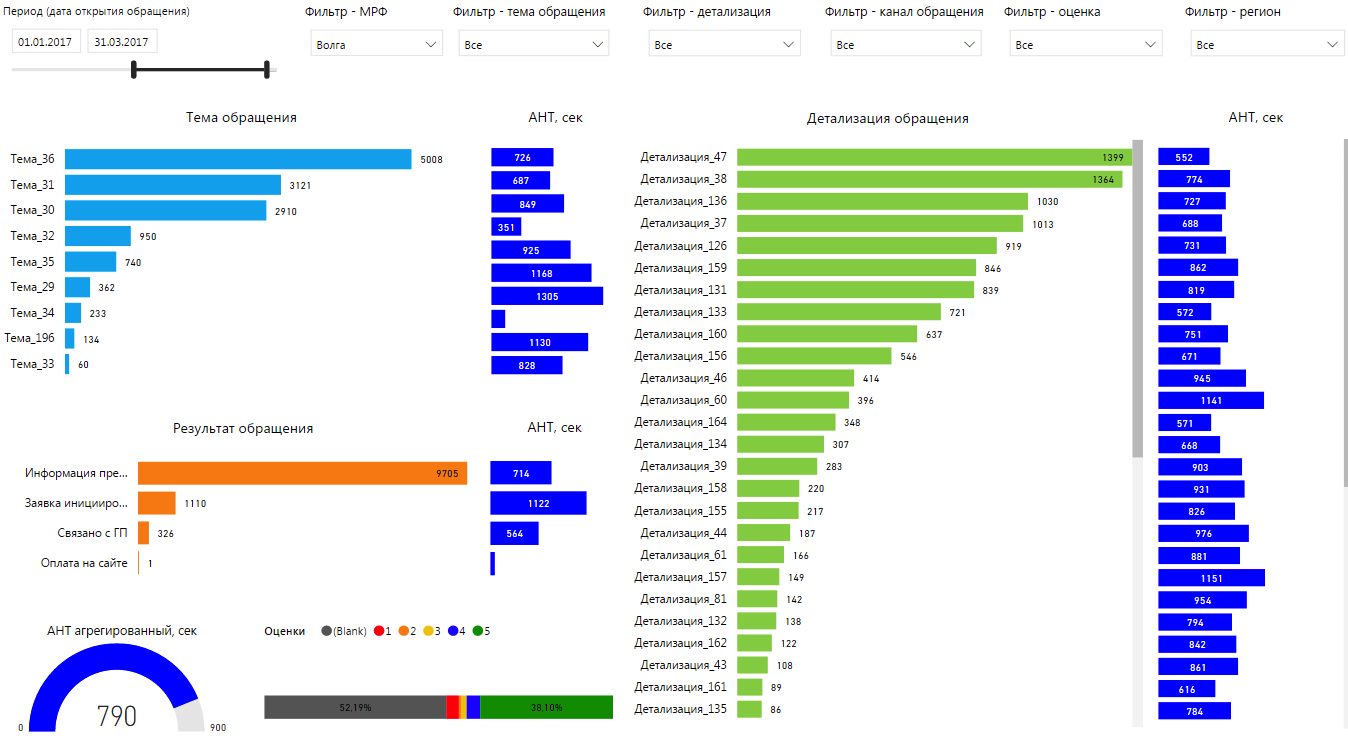
There is a dashboard for assessing the quality of work of employees - using consumer satisfaction and loyalty indices (CSI and NPS). You can scale up to each employee:
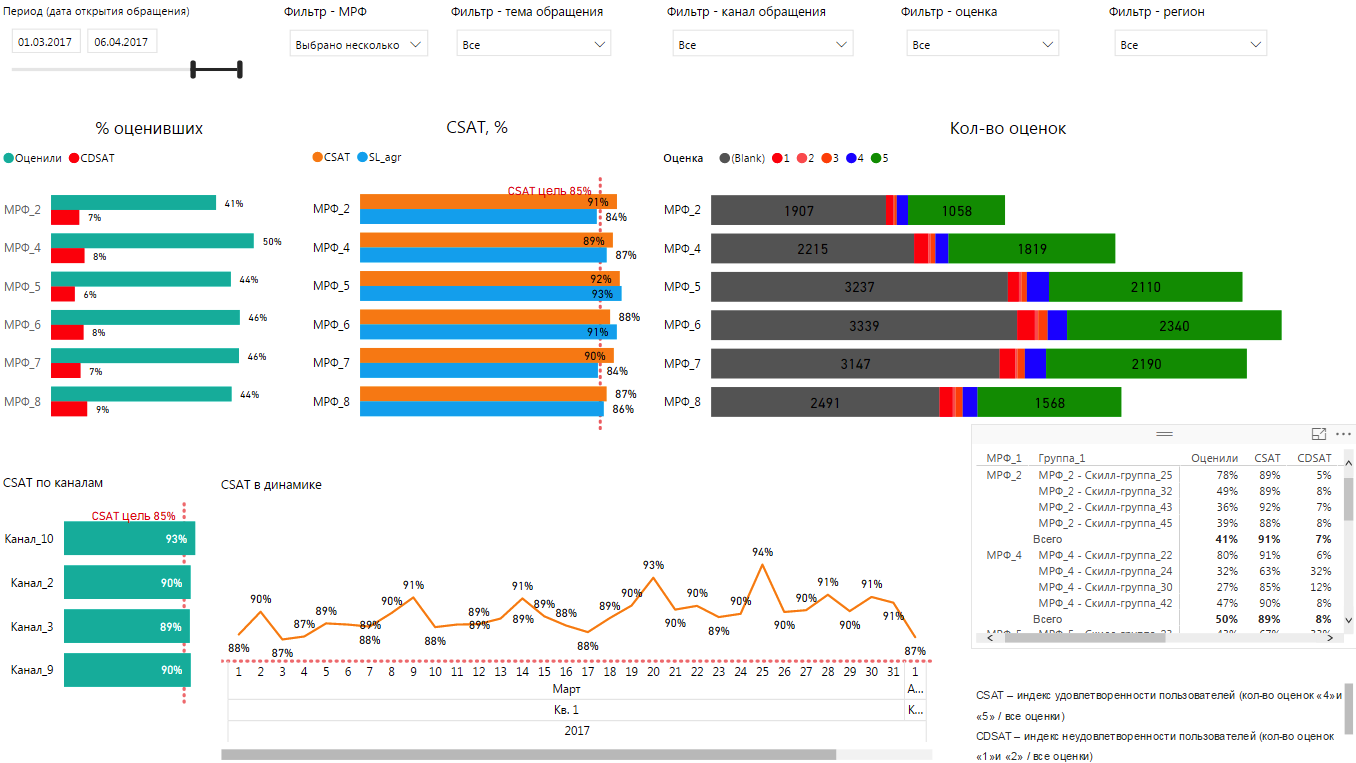
The work of each employee can be analyzed in detail through a separate dashboard, where data for analytics is accumulated for each treatment for analytics in different sections - number of characters, keywords, emotional text coloring:
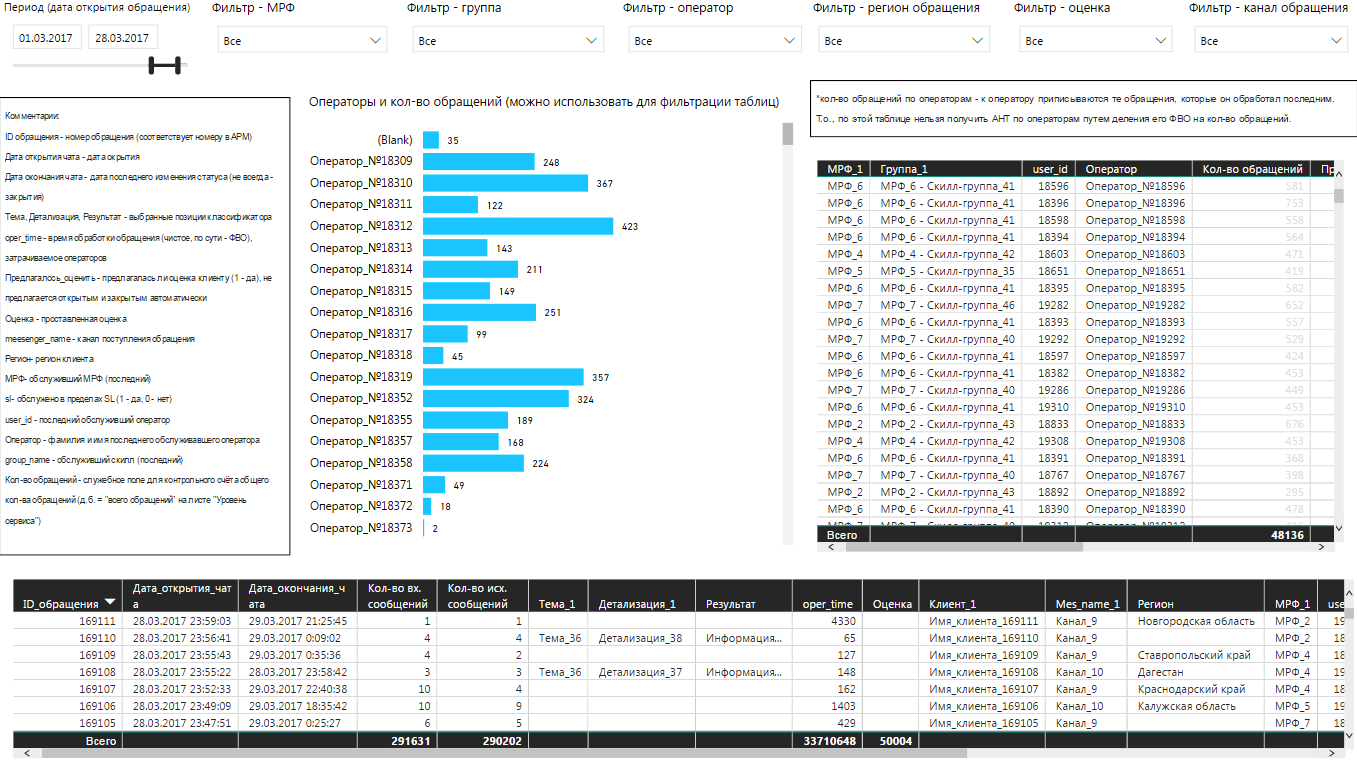
To control costs, use a dashboard with indicators of employment and disposal, at different levels and derivatives. Employment is the ratio of time when an employee actually processes an appeal, to the time when he is “in line”, that is, when he is ready to talk. Disposal is the relationship of the operator’s “in-line” time to the total time of his work shift. When the number of operators "in line" exceeds 3-4 dozens, these indicators become very important - they reflect the correct use of resources. Correctly calculate the recycling manually can not be in any way.
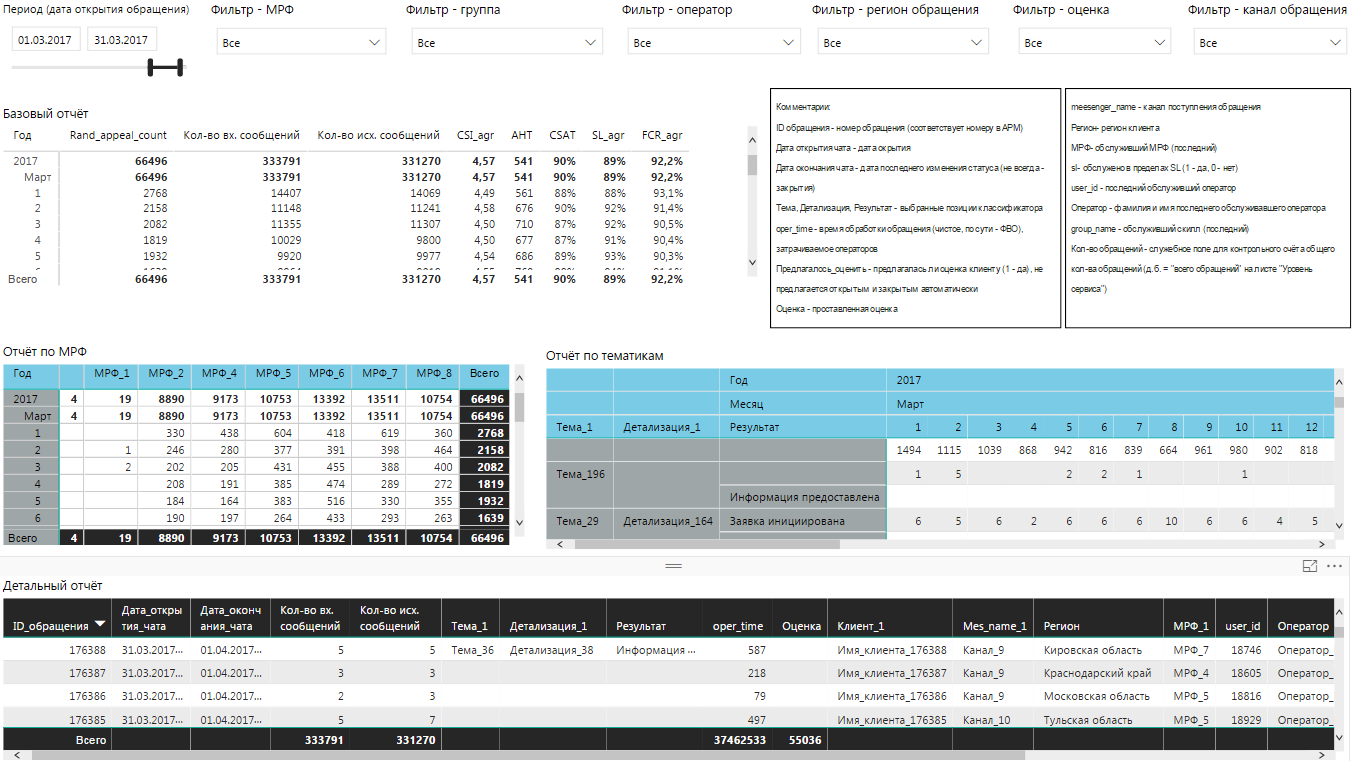
The introduction of "OmniChat" can be considered successful. About 100 thousand messages are processed daily through it. With the help of OmniChat and other measures to optimize processes, for 9 months Rostelecom reduced the processing time of calls by 40%. At the same time, customer satisfaction (CSI) is 89% (with a target of 85%), and the service level (SL) is 92%. Technical support customers are gradually leaving voice channels in chat rooms, and satisfaction with the new channel of communication is growing. There is still a lot of work on automation. Our goal is to automatically process 40% of messages in tech support.

Search solutions
Now more and more people prefer social networks and messengers to regular telephone communication. Therefore, Rostelecom decided to transfer its support to popular digital channels. We needed not just an instant messenger, but a product capable of making support manageable and convenient for analysis, to answer important questions. Why is the load on operators growing? How many need them now? Where does the money go? And this is only the most basic.
For some time we studied the platforms for handling calls in digital channels and decided to try LiveTex. When we started integrating chat into a personal account in 2015, this was the most famous and probably the most functional solution. Perhaps the LiveTex solution would be suitable for several operators who are sitting at arm's length and can solve any customer disturbances without getting up from the chairs. But for the scale of "Rostelecom" service was not sufficiently transparent and manageable.
The list of alternatives turned out to be only solutions written on the knee, which could not meet all the requirements of a large contact center. With them, sooner or later, any big company would face the fact that its support in IM channels would plunge into total chaos.
The search for third-party options resulted in the decision to try the development of one of the Rostelecom competence centers - Rostelecom Contact Center. Thus began the piloting of the OmniChat system, designed for large contact centers.
Set tasks
Its solution gives scope for scheduling tasks. The goal of Rostelecom was to increase the availability of the service for users. It was necessary to increase the number of available channels of interaction, add instant messengers and social networks. The digital platform was supposed to automate typical maintenance tasks — at least answering frequently asked questions without operator intervention or minimal intervention. And do not calm down on any chat bot, but prepare the constructor and create as many chat bots as you like for all communication channels. OmniChat had to reduce the time costs of the support service specialists, have a convenient interface and connect the knowledge base.
Finally, a tool was needed for calculating financial indicators (for example, the cost of contact with the user) using the analytics of the data that we receive through numerous interaction channels - the time of receipt of an appeal, the waiting period, the response time, etc.
"How can I help you?"
Chat rooms are chat rooms, and on the part of the screens there are still experts. And if we change the format of communication with customers, it is necessary that these specialists could easily integrate into it. At first it was not clear what to demand from future OmniChat operators how to evaluate them. They simply took the "best of the best", those who have proven themselves for a long time.

Over time, basic requirements began to form. It is important that a person knows how to type quickly and, very desirable, blindly. Writing should be competent and concise - the extra words result in extra human seconds and costs for the contact center.
But this is not the main thing. The most important skill turned out to be awareness of their responsibility for the work to the client and the company. When communicating via voice channels, everything is simpler - the client rarely sits with the voice recorder during a conversation, so minor reservations do not create problems. With chats, everything is not so - “what fell on the Internet remains there forever”. Any typo is a direct path to negativity in social networks, problems for the image. At best, everyone just laugh. It is important, for example, that “Julia” retains her beautiful name.
On the other hand, when working in chat rooms, speech defects and emphasis no longer matter. A person can burr, stutter, or “gokat”, but if he competently writes and clearly expounds his thoughts - you can take. True, only to work in text channels, but this is a nuance of internal organization.
In the regions, it was sometimes a problem to find people with computer literacy. But came across and prosharennye users who even helped to modify the interface "Omnichat", for example, to make more vivid switching between active channels.
Standardize it
At Rostelecom, we wanted to communicate with customers as positive and fun, with “emoticons and cats”, but without familiarity and rudeness. “Well said, comrade humanities, how will we automate this?”
Without a clear objective analysis of the dialogues, developing a system for communicating with customers will not work. At the time of the launch of "OmniChata" we, of course, had almost no text dialogues. But there was a mass of voice dialogues and a clear idea of their structure and logic.

It took time to create a ready base for this analysis and systematization. So, for a start, the standards of voice service were adopted as the basis for the assessment, where instructions were added on the use of emoticons, cute pictures and friendly Internet jargon.
For six months, Rostelecom, together with its partners, transferred its “voice legacy” to the base, ready for analysis. All dialogues were divided into 250 topics. In each topic, an assessment system was introduced for three components with a number of criteria included:
- The solution to the question is whether it was resolved, how quickly, etc .;
- Customer focus - how friendly the dialogue was, how the operator behaved in a conflict situation, whether there was a serious deviation from the script;
- Conducting dialogue - speech literacy, absence of typos and errors.
In addition, the assessment that the client gives to the operator is taken into account.
In the near future we will automate the quality control of the dialogs. So subjective factors will not affect the assessment - the reviewer will not know whose dialogue and from which region he is viewing. Yes, and quality control itself will accelerate.
The systematization of the dialogues has helped us very much to build optimal scripts and formulate pools of auto-answers - they are always in quick access with the operators. This, again, speeds up work and reduces the number of errors when printing messages. It’s not far from automatic replies and to creating chat bots that can automatically process messages and, at a minimum, choose the right templates for operators. You can integrate any external chat bot into OmniChat.

In general, in terms of integration, "OmniChat" turned out to be convenient. Clients have the opportunity to contact us both in Viber, and in the personal account, via chat on the site or in a mobile application. If necessary, you can integrate into the "OmniChat" VK and Facebook social networks.
Statistics platform
During the project, the opportunity to regularly upload to Excel reports on 25 important parameters was implemented: call arrival time, response time, waiting period, processing time, service level (share of the total number of calls in relation to a specific processing time threshold), call subject, etc. In addition, OmniChat's statistics and reporting can be integrated into any BI system — it will provide a report on important metrics in real time.
For operational control, statistics on key indicators are sufficient - service level, AHT (average time of communication with the client), CSAT (user satisfaction). In a separate dashboard, you can track the load on the client service. There is a geography of calls, their channels and dynamics:


Statistics can be divided into skill groups and operators:


In order to plan resources using WFM-systems or Erlang calculator, there is a dashboard with hourly load profiles by skill-groups. OmniChat can quickly distribute the load on operators and groups, allocate a queue, output the required number of operators “in line”:

To monitor the work in the context of topics there is a three-level classifier synchronized with a voice channel (CRM). Here you can also estimate the duration of work with appeals on each topic:

There is a dashboard for assessing the quality of work of employees - using consumer satisfaction and loyalty indices (CSI and NPS). You can scale up to each employee:

The work of each employee can be analyzed in detail through a separate dashboard, where data for analytics is accumulated for each treatment for analytics in different sections - number of characters, keywords, emotional text coloring:

To control costs, use a dashboard with indicators of employment and disposal, at different levels and derivatives. Employment is the ratio of time when an employee actually processes an appeal, to the time when he is “in line”, that is, when he is ready to talk. Disposal is the relationship of the operator’s “in-line” time to the total time of his work shift. When the number of operators "in line" exceeds 3-4 dozens, these indicators become very important - they reflect the correct use of resources. Correctly calculate the recycling manually can not be in any way.

Totals
The introduction of "OmniChat" can be considered successful. About 100 thousand messages are processed daily through it. With the help of OmniChat and other measures to optimize processes, for 9 months Rostelecom reduced the processing time of calls by 40%. At the same time, customer satisfaction (CSI) is 89% (with a target of 85%), and the service level (SL) is 92%. Technical support customers are gradually leaving voice channels in chat rooms, and satisfaction with the new channel of communication is growing. There is still a lot of work on automation. Our goal is to automatically process 40% of messages in tech support.
